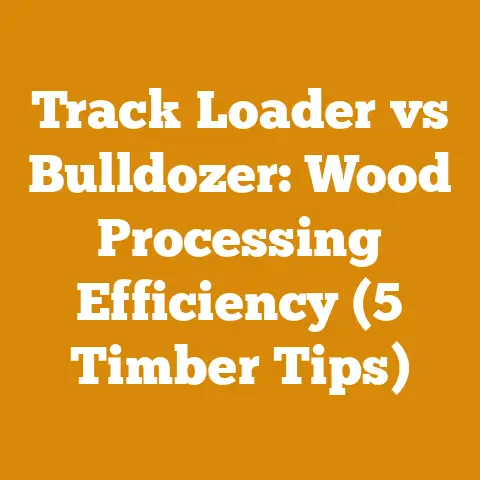Alpiner Wood Stove: Affordable Heating Tips (7 Expert Hacks)
Like a seasoned woodsman sizing up a towering oak, understanding the true cost of heating with wood requires a keen eye and a sharp mind. It’s more than just the price of the wood itself; it’s a complex equation involving equipment, labor, and a bit of good old-fashioned elbow grease. Let’s unlock the secrets to affordable heating with wood, focusing on how to maximize the efficiency of your Alpiner wood stove and keep your wallet happy.
Alpiner Wood Stove: Affordable Heating Tips (7 Expert Hacks)
The allure of a crackling fire in an Alpiner wood stove on a cold winter’s night is undeniable. However, that cozy warmth can quickly turn into a financial burn if you don’t approach it strategically. I’ve spent years felling trees, splitting wood, and optimizing my own wood-burning setup. My experiences have taught me that heating with wood affordably is entirely possible with the right knowledge and planning.
Understanding the True Cost of Wood Heating
Before diving into the hacks, it’s crucial to understand all the cost components involved. It’s not just the price per cord that matters.
- Wood Acquisition Costs: This is the most obvious cost. It can range from free (if you harvest your own wood) to hundreds of dollars per cord, depending on the species, dryness, and your location.
- Equipment Costs: Chainsaws, axes, splitting mauls, wedges, safety gear (helmet, gloves, eye protection), and the wood stove itself all contribute to the initial and ongoing expenses.
- Labor Costs: If you’re hiring someone to cut, split, and stack your wood, this can be a significant expense. Even if you’re doing it yourself, factor in your time. Time is money, as they say!
- Maintenance Costs: Chainsaw sharpening, fuel and oil for the chainsaw, chimney cleaning, and wood stove repairs are all part of the equation.
- Permitting Costs: In some areas, you might need permits to harvest wood, especially on public lands.
- Storage Costs: A proper wood shed or covering to protect your wood from the elements is essential.
Hack #1: Source Your Wood Strategically – Location, Species, and Seasonality
Personal Story: I once made the mistake of buying a “cheap” cord of wood from a guy selling it out of the back of his truck. It turned out to be a mix of softwoods, riddled with rot, and barely seasoned. It burned quickly, produced little heat, and left a ton of creosote in my chimney. Lesson learned: cheap isn’t always cheaper!
Data-Driven Insights:
- Location: Prices for firewood vary dramatically depending on your region. According to a 2023 survey by the Hearth, Patio & Barbecue Association (HPBA), the average price per cord of seasoned firewood in the Northeast United States is around \$350-\$500, while in the Southeast, it’s closer to \$250-\$400. The Midwest typically falls in between. These are just averages; prices can fluctuate based on local supply and demand.
- Species: Hardwoods like oak, maple, beech, and ash are denser and burn longer, providing more heat per cord than softwoods like pine, fir, and spruce. While softwoods are easier to ignite and are good for kindling, they’re not ideal for sustained heating. The BTU (British Thermal Unit) content of different wood species varies significantly. For example, oak can have a BTU rating of around 27 million per cord, while pine is closer to 17 million.
- Seasonality: The best time to buy firewood is in the spring or summer when demand is lower, and prices are often more competitive. Wood purchased during the heating season is usually more expensive.
Actionable Tips:
- Call around: Get quotes from multiple firewood suppliers in your area. Don’t be afraid to negotiate!
- Ask about species: Inquire about the type of wood being offered and its moisture content. Ideally, you want seasoned hardwood with a moisture content below 20%.
- Consider harvesting your own: If you have access to land and the necessary equipment, harvesting your own wood can significantly reduce costs. Just be sure to obtain any necessary permits and follow safe logging practices.
- Buy in bulk: Purchasing multiple cords at once can often result in a lower price per cord.
Hack #2: Season Your Wood Properly – The Key to Efficiency
Personal Story: I remember my grandfather always saying, “Green wood is good for building, dry wood is good for burning.” He was right! Burning unseasoned wood is like throwing money into the fire. It produces less heat, creates more smoke, and significantly increases the risk of creosote buildup in your chimney.
Data-Driven Insights:
- Moisture Content: Freshly cut wood can have a moisture content of 50% or higher. Seasoned firewood should have a moisture content of 20% or less.
- Drying Time: The time it takes for wood to season depends on the species, climate, and how it’s stacked. Generally, hardwoods need at least 6-12 months of seasoning, while softwoods can dry in 3-6 months.
- BTU Loss: Burning wood with a moisture content of 40% can reduce its BTU output by as much as 25%. That’s a significant loss of efficiency!
Actionable Tips:
- Split the wood: Splitting wood increases its surface area, allowing it to dry faster.
- Stack it properly: Stack the wood in a single row, off the ground, and with good airflow. A wood rack or pallets can help.
- Cover the top: Cover the top of the woodpile with a tarp or shed roof to protect it from rain and snow, but leave the sides open for ventilation.
- Use a moisture meter: A moisture meter is an inexpensive tool that can help you determine if your wood is properly seasoned.
- “Top Cover Only” Method: Avoid completely covering your wood pile. Covering only the top allows for proper air circulation, crucial for efficient drying. Complete covering traps moisture and slows down the seasoning process.
Calculation:
-
Estimating Drying Time: A rough estimate for drying time can be calculated using the following formula:
Drying Time (months) = (Initial Moisture Content – Target Moisture Content) / Drying Rate
Where:
- Initial Moisture Content is the moisture content of the freshly cut wood (e.g., 50%).
- Target Moisture Content is the desired moisture content for burning (e.g., 20%).
- Drying Rate is an estimated rate of moisture loss per month, which varies based on climate and wood species (e.g., 5-10% per month).
For example, drying oak from 50% moisture to 20% in a climate with a drying rate of 7% per month would take approximately (50-20)/7 = 4.3 months. Keep in mind that this is just an estimate, and actual drying times may vary.
Hack #3: Optimize Your Alpiner Wood Stove Operation – Burn Smart, Not Hard
Personal Story: I used to think that more wood meant more heat. I’d cram my wood stove full, close the damper, and let it smolder all night. I was wrong! I was wasting wood, creating a fire hazard, and polluting the air.
Data-Driven Insights:
- Airflow: Proper airflow is essential for efficient combustion. Restricting airflow leads to incomplete combustion, which produces smoke, creosote, and less heat.
- Damper Control: The damper controls the airflow in your wood stove. Closing the damper too much reduces efficiency and increases the risk of creosote buildup.
- Creosote Formation: Creosote is a flammable byproduct of incomplete combustion that can accumulate in your chimney. Regular chimney cleaning is essential to prevent chimney fires. The National Fire Protection Association (NFPA) recommends having your chimney inspected and cleaned at least once a year.
Actionable Tips:
- Use the right size wood: Don’t overload your wood stove. Use pieces that are appropriately sized for the firebox.
- Establish a good fire: Start with kindling and gradually add larger pieces of wood.
- Maintain proper airflow: Adjust the damper to allow for sufficient airflow. A bright, active flame indicates good combustion.
- Burn hot and clean: Avoid smoldering fires. Burning the wood hotter and cleaner will produce more heat and less creosote.
- Monitor your chimney: Check your chimney regularly for creosote buildup. If you notice a significant accumulation, have it cleaned immediately.
- Invest in a catalytic combustor (if applicable): Some Alpiner wood stove models come with a catalytic combustor, which helps to burn off smoke and gases, increasing efficiency and reducing emissions. Make sure the combustor is clean and functioning properly.
- Learn the “Top-Down” Burning Method: Instead of starting the fire at the bottom, arrange larger logs at the bottom, followed by smaller pieces and kindling on top. This method promotes cleaner and more efficient burning.
Hack #4: Insulate Your Home – Stop the Heat from Escaping
Personal Story: I spent years focusing on improving my wood stove and firewood preparation, but I was still struggling to keep my house warm. Then I realized that I was losing a significant amount of heat through poor insulation.
Data-Driven Insights:
- Heat Loss: According to the U.S. Department of Energy, the average home loses about 25% of its heat through the roof, 35% through the walls, and 40% through windows and doors.
- Insulation R-Value: Insulation is rated by its R-value, which measures its resistance to heat flow. Higher R-values indicate better insulation.
- Energy Savings: Properly insulating your home can significantly reduce your heating costs. The Department of Energy estimates that homeowners can save up to 15% on their heating and cooling bills by adding insulation.
Actionable Tips:
- Assess your insulation: Check the insulation in your attic, walls, and crawl spaces. Look for gaps, drafts, and signs of moisture damage.
- Add insulation: If your insulation is inadequate, add more. Blown-in cellulose or fiberglass insulation is a relatively inexpensive and effective way to improve insulation in attics and walls.
- Seal air leaks: Caulk and weatherstrip around windows and doors to seal air leaks.
- Insulate your hot water heater: Wrap your hot water heater with an insulation blanket to reduce heat loss.
- Consider energy-efficient windows: Replacing old, drafty windows with energy-efficient windows can significantly reduce heat loss.
- Focus on Draft-Proofing: Even small gaps around windows and doors can let significant heat escape. Use weather stripping and caulk to seal these areas.
Hack #5: Invest in the Right Tools – Efficiency from Start to Finish
Personal Story: I used to struggle with a dull axe and a flimsy splitting maul. It took me forever to split a cord of wood, and I was exhausted afterward. Then I invested in a high-quality splitting axe and a hydraulic log splitter. It was a game-changer!
Data-Driven Insights:
- Chainsaw Costs: A decent quality chainsaw can cost anywhere from \$200 to \$1000 or more, depending on the size, power, and features.
- Splitting Axe Costs: A good splitting axe can cost around \$50 to \$150.
- Log Splitter Costs: Hydraulic log splitters can range from \$500 to \$3000 or more, depending on the splitting force and features.
- Safety Gear Costs: Safety gear, including a helmet, gloves, eye protection, and chaps, can cost around \$100 to \$300.
Actionable Tips:
- Choose the right chainsaw: Select a chainsaw that is appropriate for the size of the trees you’ll be felling. A smaller chainsaw is sufficient for smaller trees, while a larger chainsaw is needed for larger trees.
- Sharpen your chainsaw regularly: A sharp chainsaw cuts faster and more efficiently, reducing the strain on the engine and the operator.
- Invest in a good splitting axe: A high-quality splitting axe with a well-designed head can make splitting wood much easier and safer.
- Consider a log splitter: If you split a lot of wood, a log splitter can save you a lot of time and effort.
- Maintain your tools: Keep your tools clean, sharp, and properly lubricated. Regular maintenance will extend their lifespan and improve their performance.
- Rent Before You Buy: For expensive equipment like log splitters, consider renting before investing. This allows you to assess if the tool fits your needs without a large upfront cost.
Cost Comparison Table:
| Tool | Average Cost | Pros | Cons |
|---|---|---|---|
| Chainsaw | \$200 – \$1000+ | Essential for felling trees and bucking logs. | Requires maintenance, can be dangerous if not used properly. |
| Splitting Axe | \$50 – \$150 | Affordable, good exercise, no fuel required. | Can be tiring, requires technique. |
| Log Splitter | \$500 – \$3000+ | Fast and efficient, reduces physical strain. | Expensive, requires fuel or electricity, takes up space. |
| Moisture Meter | \$20 – \$50 | Accurately measures wood moisture, crucial for efficient burning. | Requires batteries, needs to be calibrated occasionally. |
Hack #6: Maximize Heat Distribution – Spread the Warmth
Personal Story: I realized that even with a roaring fire in my wood stove, some rooms in my house were still cold. I needed to find a way to distribute the heat more evenly.
Data-Driven Insights:
- Heat Transfer: Heat naturally rises. This can lead to uneven heat distribution, with the upstairs being warmer than the downstairs.
- Fan Efficiency: Using fans to circulate air can significantly improve heat distribution. Ceiling fans, box fans, and wood stove fans can all be effective.
- Zone Heating: Zone heating involves heating only the rooms you’re using, rather than heating the entire house. This can save energy and reduce heating costs.
Actionable Tips:
- Use fans: Place fans strategically to circulate warm air throughout your home. A ceiling fan running in reverse can push warm air down from the ceiling.
- Open doors: Keep doors open between rooms to allow warm air to circulate freely.
- Install a wood stove fan: Wood stove fans are designed to sit on top of the wood stove and circulate warm air more efficiently.
- Consider a heat distribution system: If you have a forced-air heating system, you can install a heat distribution system that will circulate warm air from the wood stove throughout your home.
- Zone heating: Close off rooms that you’re not using to concentrate the heat in the areas you’re occupying.
- Maximize Radiant Heat: Clear the area around your wood stove to allow radiant heat to spread. Avoid blocking the stove with furniture.
Hack #7: Negotiate and Barter – Think Outside the Box
Personal Story: I’ve saved a lot of money over the years by bartering for firewood and logging services. I’ve traded everything from handyman work to garden produce for wood.
Data-Driven Insights:
- Bartering Value: The value of bartered goods and services is often based on their market value.
- Negotiation Skills: Effective negotiation skills can help you get the best price on firewood and logging services.
- Community Resources: Local community resources, such as classified ads, online forums, and community bulletin boards, can be a great place to find firewood and logging services at competitive prices.
Actionable Tips:
- Negotiate with firewood suppliers: Don’t be afraid to negotiate the price of firewood. Ask for a discount if you’re buying in bulk or paying in cash.
- Barter for firewood: Offer your skills or services in exchange for firewood.
- Find free firewood: Look for free firewood on Craigslist, Freecycle, or other online resources.
- Contact local logging companies: Logging companies may be willing to sell you wood at a discounted price.
- Check with tree removal services: Tree removal services often have wood that they’re willing to give away or sell at a low price.
- Consider Community Wood Banks: Many communities have wood banks that provide firewood to low-income families. Volunteering at a wood bank can be a great way to get free firewood.
Budgeting and Cost Management Case Study
Let’s consider a case study of a homeowner in rural Vermont who wants to heat their home primarily with wood.
Scenario:
- Homeowner: John Doe
- Location: Rural Vermont
- Heating Needs: 5 cords of wood per winter
- Wood Stove: Alpiner Wood Stove (efficient model)
Cost Breakdown (Option 1: Buying Seasoned Firewood)
- Price per cord: \$400
- Total cost: 5 cords x \$400/cord = \$2000
- Transportation: \$100 (delivery fee)
- Stacking: \$150 (hiring someone to stack the wood)
- Total Cost (Buying): \$2250
Cost Breakdown (Option 2: Harvesting Own Wood)
- Chainsaw: \$500 (initial investment, amortized over 5 years = \$100/year)
- Safety Gear: \$200 (amortized over 5 years = \$40/year)
- Fuel and Oil: \$50/year
- Maintenance: \$50/year (sharpening, repairs)
- Permit: \$25/year
- Labor: 50 hours x \$0 (John’s own time, but consider the opportunity cost)
- Total Cost (Harvesting): \$265/year
Analysis:
- Harvesting your own wood is significantly cheaper in the long run, but it requires a significant upfront investment in equipment and time.
- Buying seasoned firewood is more convenient, but it’s also more expensive.
- The homeowner should consider their time availability, physical capabilities, and access to land when making their decision.
Cost Optimization Strategies:
- Negotiate a lower price for firewood: John could try to negotiate a lower price with the firewood supplier, especially if he’s buying in bulk.
- Split and stack the wood himself: This would save him \$150.
- Harvest some of his own wood and buy the rest: John could harvest 2 cords of wood and buy the remaining 3 cords. This would reduce his costs while still saving time and effort.
- Improve home insulation: Reducing heat loss through better insulation would reduce the amount of wood needed, saving money on either purchased or harvested wood.
Conclusion
Heating with wood can be an affordable and rewarding way to keep your home warm in the winter. By sourcing your wood strategically, seasoning it properly, optimizing your wood stove operation, insulating your home, investing in the right tools, maximizing heat distribution, and negotiating effectively, you can significantly reduce your heating costs and enjoy the cozy warmth of an Alpiner wood stove without breaking the bank. Remember, the key is to be proactive, informed, and willing to put in a little bit of effort. Like a well-seasoned piece of firewood, your efforts will pay off in the long run.
Actionable Takeaways and Next Steps:
- Assess Your Needs: Determine how much firewood you need for the winter based on your home’s size, insulation, and climate.
- Research Local Sources: Identify potential firewood suppliers, logging companies, and tree removal services in your area.
- Evaluate Your Resources: Consider whether you have the time, equipment, and access to land to harvest your own wood.
- Create a Budget: Develop a detailed budget that includes all the costs associated with wood heating, including wood acquisition, equipment, labor, and maintenance.
- Implement the Hacks: Start implementing the tips and strategies outlined in this article to reduce your heating costs.
- Monitor Your Progress: Track your firewood consumption and heating costs to see how much money you’re saving.
- Adjust Your Strategy: Be prepared to adjust your strategy as needed based on your experience and changing circumstances.
Heating with wood is a journey, not a destination. By embracing these expert hacks and staying informed, you can ensure that your Alpiner wood stove provides you with affordable and reliable heat for years to come. Now, go forth and conquer those wood piles!






